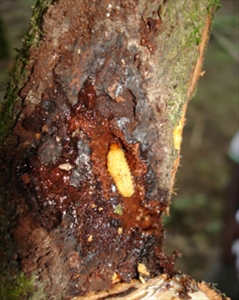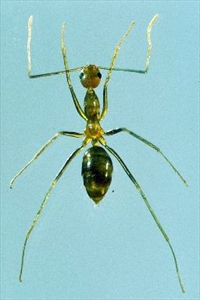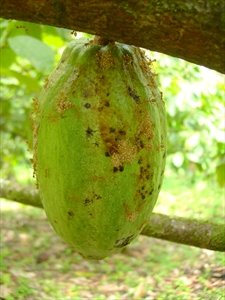Cocoa weevil borer
Pacific Pests, Pathogens, Weeds & Pesticides - Online edition
Pacific Pests, Pathogens, Weeds & Pesticides
Cocoa weevil borer (061)
Pantorhytes species. At least 13 species are recognised a pests of cocoa, most of them from Irian Jaya and Papua New Guinea. Pantorhytes biplagiatus is a serious pest of cocoa in Papua New Guinea and Solomon Islands. It is described here.
Southeast Asia (Indonesia, the Philippines), Oceania. It is recorded from Papua New Guinea, and Solomon Islands.
Cocoa and several commercial forest trees, e.g., Eucalyptus and Terminalia.
The white, oval eggs, about 2 mm long, are laid singly in crevices in the trunk and main branches, particularly near the main fork or 'jorquette'. They hatch after 2-3 weeks. The larvae bore into the wood (Photo 1), feeding for 3-9 months through nine instars, and then pupate beneath the bark for about 2 weeks.
The adults are black and red (Photo 2), wingless weevils about 1.5 cm long. They feed for 4-6 weeks before mating; afterwards, the female lays about two eggs a day throughout a life of 1-2 years. Adults feed on the bark of young cocoa shoots, flowers and, occasionally, pods (Photo 3), but the damage is not sufficient to affect pod production.
The larvae do the damage. They bore into the sapwood of trunks and branches, making tunnels 1-3 cm deep. Often the tunnels are made at or near the jorquette, the junction of branches and the trunk. Damage at the jorquette has the potential to weaken trees, causing tip dieback, death of branches, and even death of the tree if splits occur there. Consequently, pod yields may be reduced considerably.
The wounds made by larvae may allow entry of the bark canker water mould, Phytophthora palmivora (see Fact Sheet no. 06), and also termites.
Look for holes in the trunk and branches, particularly at the jorquette; look for the jelly-like substance that exudes from the holes where the larvae feed. Look for the adult beetles, that have a red abdomen with white spots, and are relatively slow moving, sufficient to be handpicked.
NATURAL ENEMIES
Biocontrol of Pantorhytes is possible using the crazy ant, Anoplolepis gracilipes (Photo 4), or Oecophylla smaragdina (Photo 5). Both these ants make colonies in soursop trees, so these should be planted between cocoa trees to encourage them. They also nest in the crown of coconuts feeding off honeydew-producing scale insects. The little fire ant, Wasmannia auropunctata, too, may be antagonistic to Pantorhytes, although this should not be intentionally introduced into cocoa plantations because of its painful bite.
The yellow-brown crazy ant has long legs and antennae (Photo 4). Its total length is about 4 mm. It kills its prey by spraying formic acid. Wasmannia is smaller.
CULTURAL CONTROL
- Handpick Pantorhytes adults (they do not have wings) during the middle of the day when they come down from the canopy to find cooler places.
- Routinely inspect trees for tunnels made by the larvae, and kill them with a piece of wire.
- If possible, plant cocoa under the shade of coconuts, forest trees, Leucaena or Gliricidia; possibly, the lower numbers under coconuts are associated with higher ant populations.
CHEMICAL CONTROL
The use of insecticides - other than as a 'paint' to kill larvae - is not recommended. Its difficult to bring chemicals into contact with the larvae inside their tunnels, and the low population of beetles makes their use uneconomic. The best method for large and small plantations is to inspect and kill the larvae as explained above. However, if chemical control is required, perhaps in severely infested plantations, do the following:
- Find the larvae by looking for frass pushed out of the entrance of the larval tunnel and/or a jelly-like substance.
- Remove the frass with a stiff brush and apply a solution of Orthene (acephate), white oil, Ridomil (metalaxyl) (or phosphorus acid), and water with a small 2 cm brush onto the bark around the entrance hole. (Metalaxyl or phosphorus acid is added to control Phytophthora). Repeat after 2 weeks, and continue to monitor the trees.
____________________
When using a pesticide, always wear protective clothing and follow the instructions on the product label, such as dosage, timing of application, and pre-harvest interval. Recommendations will vary with the crop and system of cultivation. Expert advice on the most appropriate pesticides to use should always be sought from local agricultural authorities.
AUTHORS Helen Tsatsia & Grahame Jackson
Photo 4 Global Invasive Species Database. (http://www.iucngisd.org/gisd/species.php?sc=110).
Produced with support from the Australian Centre for International Agricultural Research under project PC/2010/090: Strengthening integrated crop management research in the Pacific Islands in support of sustainable intensification of high-value crop production, implemented by the University of Queensland and the Secretariat of the Pacific Community.








